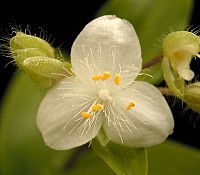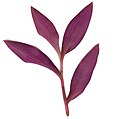You are here
Species
Tradescantia
IUCN
NCBI
EOL Text
Herbs, some erect, others prostrate and mat-forming. Inflorescences mostly terminal, composed of fused pairs of cymes, subtended by paired boat-shaped bracts. Flowers bisexual, radially symmetric. Sepals 3. Petals 3, usually free, sometimes united, blue-violet, mauve, pink or white. Stamens 6, all fertile and ± similar. Ovary 3-locular with (1-)2 ovules in each loculus. Fruit a dehiscent capsule.
| License | http://creativecommons.org/licenses/by-nc/3.0/ |
| Rights holder/Author | Mark Hyde, Bart Wursten, Petra Ballings, Flora of Zimbabwe |
| Source | http://www.zimbabweflora.co.zw/speciesdata/genus.php?genus_id=1729 |
Barcode of Life Data Systems (BOLD) Stats
Specimen Records:47
Specimens with Sequences:40
Specimens with Barcodes:36
Species:13
Species With Barcodes:12
Public Records:22
Public Species:11
Public BINs:0
Leaf and Stem: Leaves and stems are boiled, and the water drunk as a treatment for colds, by the Guyana Patamona.
|
|
This article may be expanded with text translated from the corresponding article in the Spanish Wikipedia. (December 2009) Click [show] on the right to read important instructions before translating.
|
Tradescantia /ˌtrædɨˈskæntiə/,[4] the Spiderworts, is a genus of 75 species of perennial plants in the family Commelinaceae, native to the New World from southern Canada south to northern Argentina including the West Indies. Some species have become naturalized in various regions in Europe, Asia, Africa, Australia and assorted oceanic islands.[3]
They are weakly upright to scrambling plants, growing to 30–60 cm tall, and are commonly found individually or in clumps in wooded areas and fields. A number of the species flower in the morning and when the sun shines on the flowers in the afternoon they close, but can remain open on cloudy days until evening.
The three species of Wandering Jew, one native to eastern Mexico, also belong to the Tradescantia genus. Other names used for various species include Spider-lily, Cradle-lily, Oyster-plant and Flowering Inch Plant.
Contents
Description[edit]
The leaves are long, thin and bladelike to lanceolate, from 3–45 cm long. The flowers can be white, pink, or purple, but are most commonly bright blue, with three petals and six yellow anthers. The sap is mucilaginous and clear.
Taxonomy[edit]
Subdivision[edit]
In the 1980s David Hunt divided the genus into 8[5] (later 12)[6] sections, with the nominate section (Tradescantia) further subdivided into a further four series, this superseded an earlier system by Clarke (1881).[7] Hunt originally recognised 60 species of which over half (32) he placed in section Tradescantia. Hunt's original speciation is given here, as further circumscribed by Burns et al. (2011).[8] Enlarging the sections from eight to twelve added six further species (total 68). Within section Tradescantia he distinguished the American species (series Virginianae) from the three Mexican series (Tuberosae, Sillamontanae, Orchidophyllae). 'Type' here indicates Species typica. Numbering of sections refers to Hunt's original (1980) system as a cross check to his index. The renumbered sections from 1986 are given in italics, e.g. (1)(5).
Note 1: The place of T. schippii is uncertain. Hunt indicats it is included in section Zebrina, but Burns considers the section monotypic
Note 2: T. blossfeldiana as used by Hunt and Burns is now considered a synonym for T. cerinthoides. Hunt originally listed these as separate species. Hunt also listed T. potosina and T. nuevoleonensis as separate species, but the latter is now the accepted name, while T. subramosa and T. subtilis are now considered synonyms for T. maysillesii rather than separate species.[9]
(Brazil, Uruguay, N Argentina)
(Tropical America)
(Guatemala, El Salvador, S Mexico)
(S Mexico, Guatemala, Nicaragua and Costa Rica)
(Mexico to Bolivia and Brazil)
(Mexico: Durango)
(Mexico: Chihuahua to Oaxaca)
(Mexico (Yucatán), Belize)
(Mexico: Durango)
|
(U.S.A.: Texas; Mexico: Chihuahua to Veracruz)
(Mexico to Venezuela)
|
Nothospecies[edit]
- Tradescantia × andersoniana W.Ludw. & Rohweder [12][13] Phylogenetically T. x andersoniana is situated within series Virginianae, as follows ( T. ohiensis × ( T. subaspera Ker Gawl. × T. virginiana L.)).[8]
Formerly placed here[edit]
- Callisia navicularis (Ortgies) D.R.Hunt (as T. navicularis Ortgies)
- Callisia warszewicziana (Kunth & C.D.Bouché) D.R.Hunt (as T. warszewicziana Kunth & C.D.Bouché)
- Gibasis geniculata (Jacq.) Rohweder (as T. geniculata Jacq.)
- Gibasis karwinskyana (Schult. & Schult.f.) Rohweder (as T. karwinskyana Schult. & Schult.f.)
- Gibasis pellucida (M.Martens & Galeotti) D.R.Hunt (as T. pellucida M.Martens & Galeotti)
- Siderasis fuscata (Lodd. et al.) H.E.Moore (as T. fuscata Lodd. et al.)
- Tinantia anomala (Torr.) C.B.Clarke (as T. anomala Torr.)
- Tripogandra diuretica (Mart.) Handlos (as T. diuretica Mart.)[11]
Species[edit]
By 1998 Fadden listed 70 species.,[14] while currently The Plant List accepts 75.[15]
Etymology[edit]
The name of the genus honours the English naturalists John Tradescant the Elder (ca. 1570s – 1638) and John Tradescant the Younger (1608–1662).[16]
Distribution and habitat[edit]
The first species described, Virginia Spiderwort T. virginiana, is native to the eastern United States from Maine to Alabama, and Canada in southern Ontario. Virginia Spiderwort was introduced to Europe in 1629, where it is cultivated as a garden flower.
Conservation[edit]
The Western Spiderwort T. occidentalis is listed as an endangered species in Canada, where the northernmost populations of the species are found at a few sites in southern Saskatchewan, Manitoba and Alberta; it is however more common further south in the United States south to Texas and Arizona.
Cultivation[edit]
Though sometimes considered a weed, spiderwort is cultivated for borders and also used in containers. Where it appears as a volunteer, it is often welcomed and allowed to stay. A common cultivar group is derived from the naturally occurring interspecific hybrid (nothospecies) Tradescantia × andersoniana also referred to as 'Andersoniana Group'.[17] An example is 'Karminglut' ('Carmine Glow').[18]
Toxicity[edit]
Some members of the genus Tradescantia may cause allergic reactions in pets (especially cats and dogs), characterised by red, itchy skin. Notable culprits include T. albiflora (Scurvy Weed); T. spathacea (Moses In The Cradle); and T. pallida (Purple Heart).
Uses[edit]
The cells of the stamen hairs of some Tradescantia are colored blue, but when exposed to sources of ionizing radiation such as gamma rays, the cells mutate and change color to pink; they are one of the few tissues known to serve as an effective bioassay for ambient radiation levels.[19]
Radiation induced chiasma[edit]
A chiasma (pl. chiasmata) is a cytologically visible interchange at corresponding points between homologous chromosomes. It is the basis for crossover recombination during meiosis. The effect on chiasma frequency of the irradiation of different premeiotic and early meiotic stages was investigated in Tradescantia paludosa.[20] Chiasma frequency was found to increase following irradiation of the late zygotene early pachytene stages of meiosis. This finding may reflect increased homologous recombinational DNA repair in response to increased radiation-induced DNA damage.[21]
References[edit]
- ^ Linnaeus Sp. Pl.: 288 (1753).
- ^ a b "Genus: Tradescantia L.". Germplasm Resources Information Network. United States Department of Agriculture. 2004-08-10. Retrieved 2011-03-20.
- ^ a b Kew World Checklist of Selected Plant Families
- ^ Sunset Western Garden Book, 1995:606–607
- ^ a b Hunt, David R. (1980). "Sections and Series in Tradescantia: American Commelinaceae: IX". Kew Bulletin 35 (2): 437–442. JSTOR 4114596.
- ^ a b Hunt, David R. (1986). "Campelia, Rhoeo and Zebrina united with Tradescantia: American Commelinaceae: XIII". Kew Bulletin 41 (2): 401–405. JSTOR 4102948.
- ^ C B Clarke Commelinaceae. In A. & C. De Candolle Monogr. Phan. 3: 288, 113-324 (1881).
- ^ a b Jean H. Burns, Robert B. Faden, and Scott J. Steppan. Phylogenetic Studies in the Commelinaceae Subfamily Commelinoideae Inferred from Nuclear Ribosomal and Chloroplast DNA Sequences. Systematic Botany, 36(2):268-276. 2011. DOI 10.1600/036364411X569471
- ^ World Checklist of Selected Plant Families
- ^ "Tradescantia". Integrated Taxonomic Information System. Retrieved 2011-06-16.
- ^ a b "GRIN Species Records of Tradescantia". Germplasm Resources Information Network. United States Department of Agriculture. Retrieved 2011-06-16.
- ^ Feddes Repert. Spec. Nov. Regni Veg. 56: 282 (1954)
- ^ World Checklist
- ^ Faden, R. B . 1998 . Commelinaceae . Pp. 109 – 127 in The families and genera of vascular plants vol. 4 , ed. K. Kubitzki . Berlin : Springer
- ^ The Plant List
- ^ Quattrocchi, Umberto (2000). CRC World Dictionary of Plant Names: Common Names, Scientific Names, Eponyms, Synonyms, and Etymology. IV R-Z. Taylor & Francis US. p. 2697. ISBN 978-0-8493-2678-3.
- ^ Floridata
- ^ Dave's Garden
- ^ Ichikawa, Sadao (1972). "Somatic Mutatiion Rate in Tradescantia Stamen Hairs at Low Radiation Levels: Finding of Low Doubling Doses of Mutations". The Japanese Journal of Genetics 47 (6): 411–421. doi:10.1266/jjg.47.411.
- ^ Lawrence, C.W. The effect of radiation on chiasma formation in Tradescantia. Radiation Botany Volume 1 (1961-1962), pages 92-96. DOI: 10.1016/S0033-7560961)80011-2
- ^ Bernstein H and Bernstein C (2013). Evolutionary Origin and Adaptive Function of Meiosis. In Meiosis: Bernstein C and Bernstein H, editors. ISBN 978-953-51-1197-9, InTech, http://www.intechopen.com/books/meiosis/evolutionary-origin-and-adaptive-function-of-meiosis
Bibliography[edit]
Gallery[edit]
-
Front view of leaves of Tradescantia pallida cv. "Purple Heart".
-
Back view of leaves of Tradescantia pallida cv. "Purple Heart".
-
Front view of leaves of Tradescantia zebrina cv. "Tricolor".
-
Back view of leaves of Tradescantia zebrina cv. "Tricolor".
| License | http://creativecommons.org/licenses/by-sa/3.0/ |
| Rights holder/Author | Wikipedia |
| Source | http://en.wikipedia.org/w/index.php?title=Tradescantia&oldid=633627801 |
Guyana Patamona: or-rai-yik.














